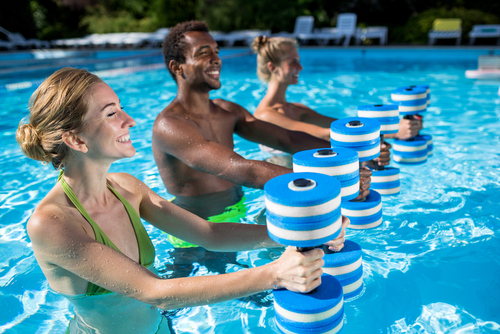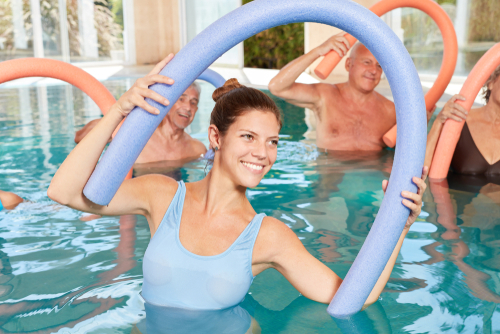The Ins and Outs of Water Aerobics

The term “water aerobics” refers to a set of anaerobic exercises that are performed in a swimming pool or another reasonably shallow body of water. Although it counts as resistance training, water aerobics requires minimal equipment and instead relies on the water itself to provide the resistance that strengthens the muscles.
In order to help you decide if this type of workout is right for you, we have prepared a brief guide on San Diego water aerobics and answered some common questions people have about this kind of water exercise. Read on to learn more.
What type of exercise is water aerobics?
Water aerobics (also called aqua aerobics) is a low impact anaerobic workout that’s done in water. Most of these exercises are done while the individual is standing upright, and generally do not include swimming or use of heavy equipment.
This makes injuries extremely unlikely and doesn’t strain the joints. As a result, water aerobics is especially popular with seniors, individuals who are recovering from surgery, and people with chronic conditions such as lower back pain.
You should consider doing aqua aerobics if you’re looking to:
- Work out all major muscle groups
- Lose weight and burn calories
- Improve your coordination and balance
- Relieve stress and anxiety
- Improve the quality of your sleep
- Increase your flexibility
- Control your blood pressure
- Lower your blood sugar and cholesterol
- Tone your muscles
- Reduce lower back pain
- Improve your cardiovascular health
- Exercise during pregnancy
Is water aerobics considered cardio?
Most people associate the term “cardio” with long distance activities such as biking, running, hiking, or swimming. Although these activities indeed fall under the cardio umbrella, the reality is that any exercise can count as cardio.
This is because, in fitness terms, cardio is any exercise that raises your heart and breathing rates, while also boosting the function of your lungs, heart, and circulatory system. This helps you burn calories, improves your metabolism, and strengthens your lungs and heart.
So the answer is yes, water aerobics definitely counts as cardio. However, it also incorporates resistance training because your muscles are constantly “fighting” against the buoyancy of the water. This not only strengthens and tones your body, but also enables you to burn extra calories.
What should I expect from my first water aerobics class?
Aqua aerobics classes generally take part in reasonably shallow water. Since you’ll always be able to keep at least one foot on the bottom of the pool, you don’t have to be a strong swimmer to engage in water aerobics. All you really need is a swimming costume!
A typical water aerobics class includes:
- A short warm-up that gets your muscles ready for the workout
- Cardiovascular exercises designed to get your blood pumping (jogging, body twists, leg kicks, arm stretches, etc.)
- Balancing exercises
- Coordination exercises
- Stretching exercises
- Cool-down exercises at the end of the workout (these are necessary to prevent injury or soreness)
Your aqua aerobics class may also include props such as ankle weights, pool dumbbells, webbed gloves, floats, and other items designed to increase resistance and make the training more effective.
Where can I enroll in a first-rate San Diego water aerobics class?

Located right next to the Mission Beach Boardwalk, The Plunge has been the top public pool in San Diego for nearly a century. In addition to the famous 10,500 square foot pool, members and visitors can also enjoy high-quality swim lessons, water aerobics programs, and even rent the pool for private parties.
Give us a call today if you’d like to learn more about who we are and what we provide, or if you’d like to inquire further about our day rates and membership benefits. We can’t wait to meet you!